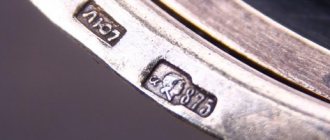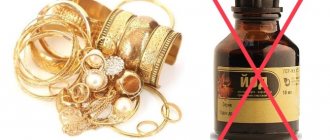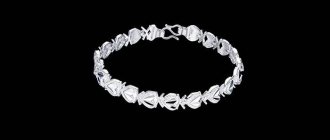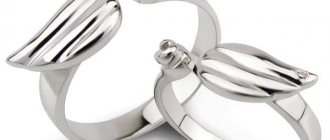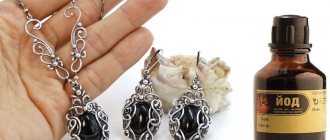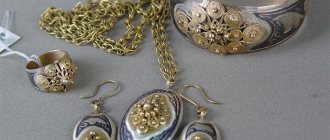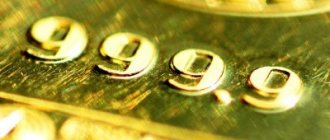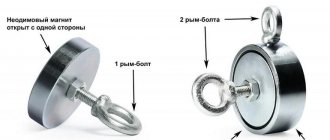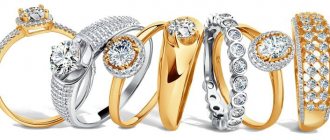From generation to generation, the attitude towards gold is passed on as an unusual metal. Gold jewelry on a person is a sign of wealth, nobility, and success. In other words, they show the status of the owner. It has its own characteristics and, one might say, abilities. Gold is ductile, dense and resistant to oxidation. This raises the question: “Is gold magnetic?” To some it seems real, to others it doesn't. And since such a beautiful metal costs a lot of money, you can easily encounter fakes. In this article we will look at the properties of gold, whether it can be attracted to a magnet, and how to distinguish real jewelry from fake.
Features of interaction
Gold is a very elegant and unique metal. It is acid resistant, high density, soft, malleable and inert. If pure gold of the highest standard is brought to a magnet, the bar will not be attracted because it has anti-magnetic properties. The same thing happens with silver and bismuth. A magnet not only does not attract such types of metals, but also repels them.
Absolutely pure gold cannot be found in jewelry products. In this form, the metal is very ductile and fragile, so it is not suitable for long-term wear as decoration. The jewelry industry found a way out and began to make an alloy of metals.
Compounds of gold with the following metals make jewelry more durable:
- silver;
- zinc;
- palladium;
- platinum;
- copper;
- nickel.
Are alloys with gold magnetic?
The magnetic field attracts the following types of heavy metals:
- steel;
- iron;
- cadmium;
- cobalt;
- nickel;
- gadolinium.
From this we can conclude that gold itself is not magnetic. Only jewelry made from the metals listed above, which may have gold plating, are attracted to the magnet.
You can find out the composition of a piece of jewelry by an engraved sample.
Sometimes people come across reviews that only the fastening mechanism of the product is magnetic. This is due to the carbon steel from which the fastener is made. If the base of the product is not magnetic, you can safely purchase it for yourself.
What does magnetization mean?
It’s easy to imagine the surprise of a person who decided to test his jewelry in this way and discovered that it was sticking to a magnet. What does this phenomenon indicate?
If a bracelet, earring, or ring sticks, it means that they have a component that can be affected by a magnetic field. Therefore, if gold has a purity of 585 and higher, but it has not passed a home test for authenticity, then it is 100% likely that it is just a fake containing iron, steel, cobalt, etc. It may also be that the fake is almost 100% copper, which is weakly, but still, magnetic. Often, fakes are made from copper, and to make them look like gold they are covered with a layer of gilding. In addition, such chains, rings and earrings may also have a hallmark, but upon inspection it turns out that the “jewel” is actually costume jewelry.
The most popular alloys from which counterfeit jewelry is made are:
If a product sticks to a magnet, you should contact a professional to determine its authenticity. Using reagents and special equipment, a specialist will check the product in a matter of minutes and form an assessment of its authenticity. As for home methods for checking rings, bracelets, pendants and chains, none of them can guarantee one hundred percent reliability of the results obtained.
Source
Authentication
Many people have encountered metals that are very similar in appearance to gold, but do not have its unique properties.
List of metals resembling gold:
- aluminum bronze alloys, largely consisting of copper and a small amount of aluminum;
- Bartbronze alloys, half of which are bronze and tin.
Some dishonest manufacturers make fakes of real gold from copper, since they have a similar appearance. For a successful scam, manufacturers cover the fakes with gold. It will not be possible to test the above-mentioned metals using a magnetic field, since they are practically not magnetic. It follows from this that you cannot be sure whether gold is real or not using a magnet alone. Although taking a piece of magnet with you to a jewelry store has become a common practice for some buyers. Of course, this may help, but it will not give a 100% guarantee.
We offer several methods for determining the authenticity of a product that can be tested in the store or at home.
Try
What is a sample? In fact, it is a measurement of the number of grams contained in an alloy of pure metal. The lower the indicator, the worse the quality. Sometimes a sample is called a jewelry passport, so the manufacturer must treat its application with responsibility and care.
Let's start with the fact that the mere presence of a sample is not a guarantee that the jewelry is made of gold, especially since it is not so difficult to make.
Gold has a standard purity of 375 - this is the lowest, in addition there are: 500, 583, 585, 750, 916, 958, and finally the highest - 999.
Sometimes looking at a stigma is not the easiest thing to do. Use the old method and enlarge it with a magnifying glass. Or use a more modern method - zoom in on your phone. The sample should not be crooked or blurry.
Smell
One of the easiest ways to determine the authenticity of yellow metal is to smell it. Real gold is odorless, while other compositions have a recognizable metallic aroma.
Joints
Most often, color differences between links and joints can be seen on jewelry for the hands and neck. This is due to the fact that gold soldering is performed with higher grade solder and it is easier to melt it. If you find differences in colors, this is normal and means that the product is made of natural gold. If there is no difference, check the authenticity of the accessory again using another method.
Vinegar
Tell the service person that you plan to test the metal using vinegar. The seller's reaction can say a lot. If he or she begins to become noticeably nervous, you may not rush to the grocery store; most likely, the product is counterfeit. A knowledgeable and confident specialist will not doubt the quality of the product and will not worry in such a situation.
The fact is that fake gold will begin to darken when exposed to vinegar. And it won't take much time. Fill a quarter glass with the clear product and dip the accessory in it for five minutes. This will do nothing for high-grade metal.
Iodine
Rub the yellow metal on any thick material of clothing, and then apply a drop of iodine to the affected area. The manifestation process will take a minute. If the gold is real, then it will not darken, but if not, the conclusion is obvious.
Keep in mind that copper and brass do not change when exposed to a dark solution, so you should not trust only one method and it is better to check something else.
Do not test 585 or lower grade jewelry using iodine. This may result in the item requiring polishing.
Sun and shadow
The peculiarity of a real gold product is that, regardless of the lighting, it will shine the same. Look at the accessory in dim light and under the rays of the sun. If you are unsure about the intensity of the sparkle, take a proven gold piece and look at it.
Rye bread
The method is reliable, but unlike other methods, it takes longer.
- Break off a small piece of dark bread.
- Squeeze lightly and mix with water.
- Cover the accessory with the mixture.
- Set aside for a while and return to it when some of the rye bread has dried out.
- Break the crumb.
As a result, darkened marks may appear. If they are present, then the metal in your hands is not original.
Pawnshop
Employees working in a pawn shop can boast of their knowledge more than some salespeople in jewelry stores. They have touched and seen many originals and fakes, and they rarely make mistakes with real gold. You can contact them for a paid consultation, it usually costs around 400-600 rubles.
Jeweler
Masters of their craft can distinguish gold from fake with just one glance. If there is any doubt, they can use special equipment. The technique can not only determine the authenticity, but also indicate the sample of the jewelry. Any work must be paid, and the services of a jeweler are no exception. Such assistance will cost no more than a thousand rubles, usually less.
Basic properties of gold
But based on the magnitude of magnetic susceptibility, all metals are divided into three groups:
We have often heard about a magnet for gold and silver. For metals such as copper, gold, silver, etc. even the magnetic field of strong neodymium magnets does not have a strong effect and is not visually noticeable.
Separately, mention should be made here of neodymium magnets.
However, it should be noted that a neodymium magnet does not attract:
Most people ask the question “are there magnets that interact with noble metals?”
So-called prospecting magnets cannot directly magnetize gold or silver, but with the following caveat:
Describing this situation, I would like to note that in the modern world there are a huge variety of ways to check the authenticity of precious metals - laboratory tests, the use of chemical reagents and much, much more. Therefore, it does not make sense for you to use any magnets when there are much more reliable sources of information about the precious metal.
Source
How not to check for authenticity
Sports champions are often photographed biting their gold medals. This is not the case when you should follow an example from them. Few people know, but usually such awards are made with gilding, and a photo with a bite is taken just for the sake of the frame. Gold has a soft structure and when squeezed with teeth, marks can form on it. The seller will obviously not like this, who will oblige you to buy the bitten product. Keep in mind that it’s exactly the same story with fake aluminum, so when a store offers to do a “tooth test,” you shouldn’t do it.
Is it possible to magnetize gold?
There is probably no woman on earth who does not love gold jewelry and jewelry. Does the happy owner of a gold ring know that it is magnetic? Or is it not magnetic? So is it magnetic or not?! This is what we will find out in this article.
We have all often heard that gold is a noble metal, or precious. But what did he do to deserve these proud names? We all know from our school chemistry course that ordinary metals react with oxygen and become oxidized.
But gold, silver and platinum do not react with oxygen, but retain their structure and appearance under such circumstances. It can only be dissolved in “aqua regia” - a mixture of hydrochloric and nitric acids, and even then only in concentrated form. It is this, as well as the rarity and strength of the metal, that has led to gold acquiring such great value and significance.
Gold, like all metals, has approximately the same properties. So is gold magnetic or not? An interesting and sensible question. Let's look at it in order.
Types of magnets
There are two types of search magnets:
• one-sided – magnets are aimed at vertical search; • double-sided – the devices are suitable for casting from the shore or vertical search.
Magnets also differ in weight and cost - more power means a higher price, respectively.
Not only the high cost of this alloy is its disadvantage. There is also a low-quality protective coating, which is erased during the use of the metal. It would seem that any coating deteriorates over time, but in this case the functionality of the magnet will become much worse, and rust will also form on the surface. To prevent this phenomenon, it is strongly recommended that the search magnet be washed, cleaned and dried after each use.
When purchasing a magnet for the purpose of searching for precious metals, you must be aware that such a purchase may not be profitable. Alternatively, it is permissible to use a magnet together with other devices and tools - this is the only way to most likely get what you want.
When gold is magnetic
Surely many people know that most jewelry consists of noble metals that are far from pure. The amount of precious metals in nature is negligible, and extracting them is very difficult. This is the main reason why jewelers add certain metals to gold, platinum or silver. Often, nickel and copper may be introduced for certain purposes, as they are not considered particularly valuable.
Today, jewelry production is full of real accomplices, whose works cannot be distinguished from original products without special equipment. In this case, you can check the authenticity of the jewelry using a magnet. So, if a piece of jewelry “responded” to a magnet and was attracted to it, it means that it contains a small amount of gold and many alloys. Gold plating is applied as a coating to absolutely any metal, so it is important to remain vigilant here and study the jewelry - the correspondence of weight, the presence of hallmark.
If a piece of jewelry reacts to a magnet, it is imperative to check its quality and authenticity with a specialist in a jewelry workshop. Alternatively, you can test the jewelry yourself.
Pure gold is quite difficult to find, so if the precious metal contains certain elements, the magnet is able to react to them. Of course, the probability in this case is low, but there is no need to lose hope.
In other words, gold can be magnetic under certain conditions:
1. The precious metal contains impurities that tend to react to a magnet. 2. The product is a fake, which is covered with gold. 3. Gold can make up some part of the entire alloy, and it can be detected due to its luster and color.
Not everyone knows that there are metals in the periodic table that do not react to a magnet and can be used for bad purposes.
These elements are:
Thus, when these elements are added to the alloy, it is completely impossible to distinguish jewelry from fakes. These metals also cannot be found at the bottom of the river.
Gold with magnetic properties may exist in nature, but in very limited quantities. Experts advise using a metal detector in this case.
Advantages and disadvantages
The indisputable advantage of a magnet is its ease of use:
- it does not require special storage conditions; you should, perhaps, avoid heating it above 80 degrees;
- does not need recharging;
- has a very simple design;
- takes up little space.
The disadvantage is that it cannot be used to extract gold, silver, and their alloys, including nuggets.
Another thing is metal detectors. The advantage of modern metal detectors is their ability not only to find, but also to distinguish which metal is within its coverage area. How does this feature work? This was made possible thanks to the use of a computer in the design of the device, which analyzes all incoming signals, reacting to the smallest changes.
What determines the magnetic properties of gold?
Read in this article:
Is gold magnetic? The answer to this question can be learned from a chemistry course. Studying the properties of metals that are of noble origin, one can notice one similarity - they all do not react to a magnet.
It is impossible to attract gold or silver with a magnet. But many treasure hunters claim that with the help of a powerful magnet they were able to find jewelry made of gold or silver. Is this so or are braggarts simply talking about something that, in principle, cannot be?
Tips for choosing
In addition to their shape, the devices also differ in the strength of the radiation and the method of attaching the cable.
Experienced treasure hunters are advised to choose powerful double-sided magnets, since they are universal and easy to use, although they are more expensive.
Weight and ammunition
Any tool is most effective if it is selected in accordance with the task at hand. The choice of magnet is no exception. To begin with, you should decide what items it will be used to search for, and based on this, select the appropriate device.
It should be taken into account that the higher the power of the magnet, the greater its mass and cost. The optimal option is 400 kilograms. This is not the weight of the magnet, but the weight it can lift!
In addition to the magnet itself, you will need a cable with which the search device can be lowered to the bottom of the reservoir. It is better to choose ammunition with a large margin of safety, exceeding the power of the magnet itself, in order to avoid ruptures and loss of the device. Finding him later is almost impossible.
Review of popular devices and their prices
The most well-known magnet manufacturers offer devices of varying power and cost:
- NPK Supersystem produces a wide range of magnets. A device capable of lifting a weight of about 90 kg will cost about 700 rubles. For a very powerful double-sided copy, designed for 690 kg, you will have to pay more than 7,000 rubles.
- CJSC NPO Redmag produces magnets with a capacity of 600 kg and a cost of 3-5.5 thousand rubles.
- Magnets made in China are also very popular. A device with a capacity of 600 kg can be purchased for 4900 rubles, devices with a capacity of 300 kg are sold at a price of 2700-2800 rubles.
Summarizing
So, gold in its pure form is not prone to magnetization. This suggests that when gold jewelry reacts to the action of a magnet, one should definitely doubt its quality and authenticity. It is possible that elements that are difficult to identify without special equipment have been added to the precious metal alloy. This is often done with the aim of making easy money. If a similar situation occurs and the gold you are buying is drawn to the magnet, you should not rush - it is better to visit a specialist in a jewelry workshop.
Source
Is gold magnetic?
From generation to generation, the attitude towards gold is passed on as an unusual metal. Gold jewelry on a person is a sign of wealth, nobility, and success. In other words, they show the status of the owner. It has its own characteristics and, one might say, abilities. Gold is ductile, dense and resistant to oxidation. This raises the question: “Is gold magnetic?” To some it seems real, to others it doesn't. And since such a beautiful metal costs a lot of money, you can easily encounter fakes. In this article we will look at the properties of gold, whether it can be attracted to a magnet, and how to distinguish real jewelry from fake.
Principle of operation
A neodymium magnet forms a field that allows it to attract objects that exceed the weight of the search device by tens of times, depending on its size and power. This device works great both in air and under water.
Working with the device is simple - just attach it to a rope and lower it to where the item you are looking for is supposed to be located. Under the influence of a magnetic field, metal objects “stick” to the device and can be removed to the surface.
What is a search magnet for?
A search magnet is not an easy thing, and its main purpose, as many inexperienced people believe, is to search for nuggets. However, this version is extremely superficial and has not been confirmed by anything, therefore, throwing it aside, we can highlight more logical and explainable purposes of the magnet:
• will be useful when retrieving a lost item from the bottom of a lake or river; • used to extract cargo from a deep hole or well; • pull out metal sunk in the swamp.
Interestingly, all the places that cannot be reached with a metal detector can be checked using a search magnet.
A search magnet is a special device made of rope and magnet. The magnet is created on the basis of an alloy of boron, iron, neodymium - this combination of metals provides a force that can attract a load weighing up to 600 kg.
The magnet must be cleaned after each use. Otherwise, the formation of plaque on the metal surface cannot be avoided - this will affect its properties and power. Experts note that when an alloy of iron, bromine and neodymium is heated to 80 degrees, it completely loses its properties, and it is no longer possible to restore them.
It is known that after 10 years of operation, the magnet becomes weaker by only 1%. This means that purchasing this device is a fairly profitable investment.
When will a magnet attract gold?
Jewelry, as you know, is made not only from precious metals, which are so valued. In nature, their number is limited, and extraction is associated with certain difficulties. For this reason, jewelers dilute silver, gold or platinum with other metals. Copper, nickel and other elements that are not of particular value are added to the alloy.
Gold ring and magnet
Some craftsmen prepare high-quality fakes; it is difficult even for a jeweler to distinguish them from jewelry. You can use a magnet to check the authenticity of a product. If a piece of jewelry is attracted to a magnet, it means that it contains little gold and a lot of impurities. Gold plating can be applied to any metal. But the main thing is not to lose vigilance and examine the jewelry for the presence of the sample and determine the weight.
If a magnet has attracted a chain or ring, it is better to take the jewelry to a workshop for inspection or conduct a series of tests yourself.
In nature, a metal such as gold in its pure form is rare; if the nugget contains other elements, the magnet can react to them. The probability of this happening is low, but you should not lose hope.
So, let’s clarify why a precious metal can react to a magnet:
There are several more elements in the periodic table that, like noble metals, do not react to a magnet. These include:
If these components are added to the alloy, then jewelry cannot be distinguished from a fake in this way. It will also not be possible to find aluminum or copper at the bottom of a river or well.
Magnetic gold or silver can be found in nature; experts do not rule out that searching for the precious metal in this way can bring success. But the chances of this are extremely low. It is better to use other devices, for example, a metal detector.

